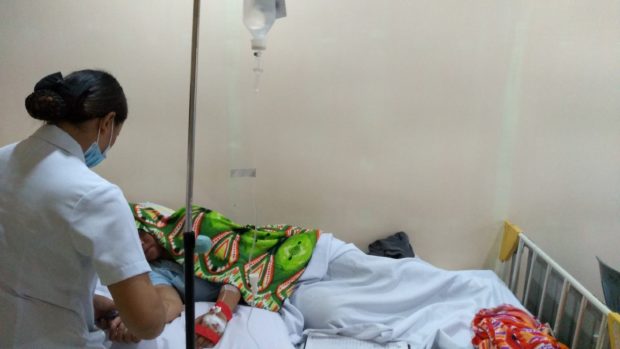
HOSPITAL STAY A nurse checks on a dengue patient in one of the private hospitals in Koronadal City. South Cotabato is among the latest provinces to tap calamity funds to check the spread of the mosquito-borne disease. —BONG SARMIENTO
Two more provinces — Leyte and South Cotabato — have declared a state of calamity as dengue has claimed close to 500 lives and infected some 116,000 people across the country since the start of the year.
Zamboanga Sibugay, which saw an almost 2,000-percent increase in dengue cases since January, was the first province in the country to approve the declaration on July 16 to allow it to release calamity funds to combat the disease.
There is no known cure for dengue fever, which is caused by a virus spread by the Aedes aegypti mosquito. Dengue can be fatal.
The Department of Health (DOH) raised a nationwide dengue alert on July 15. Since January, at least 491 people have died of dengue.
From January to July 12, Leyte, excluding the cities of Tacloban and Ormoc, recorded 1,747 cases and six deaths.
Tacloban has 407 cases with six deaths. No available information was available for Ormoc as of press time.
The top five areas in Leyte, which have more than a hundred dengue cases, are Baybay City (155); Jaro (126); Palo (123); Sta. Fe (217); and Alangalang (118).
Room shortage
In Koronadal City, capital of South Cotabato, private hospitals are running out of rooms for the growing number of patients with dengue.
As of 9:30 a.m. on Sunday, Allah Valley Medical Specialists Center, a tertiary hospital with at least 100 beds, declined to accept reservations as all its rooms were already occupied.
But the medical center still advised patients to register for admission and wait in the emergency room for a fee of P500 for every four hours, so they would get priority once other patients were discharged.
Socomedics Medical Center also said it no longer had rooms available for patients when sought for comment by the Inquirer on Sunday. At Dr. Arturo P. Pingoy Medical Center, only one bed at the ward section was not occupied.
“The rise in dengue cases is alarming. Our public and private hospitals are being crowded mostly by dengue patients,” Vice Gov. Vicente de Jesus earlier said.
The provincial health office reported 3,347 dengue cases in South Cotabato from Jan. 1 to July 13, a 149-percent rise from the 1,344 dengue cases in the same period last year.
Health officials also monitored 21 deaths due to dengue in the province. They considered the increase in the number of cases “above the epidemic threshold.”
The provincial councils of Leyte and South Cotabato simultaneously declared a state of calamity on Friday.
Leyte provincial board member Raissa Villasin, who sponsored the resolution, said the calamity funds would be used to procure medicines and fogging machines.
Of the 10 towns in South Cotabato, Surallah, Tantangan, Norala, Banga and Santo Niño towns had already declared a state of calamity before the provincial council did.
Renette Bergado, the provincial administrator, said P5 million from the P31-million quick-response calamity fund would be tapped to deal with the outbreak.
The amount would be used to buy fogging machines and conduct a massive dengue awareness campaign, among other measures, said Bergado, acting head of the Provincial Disaster Risk Reduction and Management Council.
The DOH in Central Visayas has called on people to volunteer and help the enhanced “barangay dengue brigades.”
Dr. Jaime Bernadas, health regional director, noted that the brigades had limited manpower, consisting mostly of barangay officials and health workers.
Most of the barangays whose dengue brigades are inactive are often the ones with high dengue incidence, he said.
He said brigade members could help educate the community on how to avoid dengue and know its symptoms and signs. They will also help destroy possible breeding grounds of mosquitoes, he said.
In schools, the DOH will continue to distribute mosquito-repelling curtains.
Dengvaxia update
From Jan. 1 to July 13, 9,594 dengue cases and 62 deaths had been been recorded in Central Visayas. Last year, there were 3,823 cases and 25 deaths in the same period.
A House leader on Sunday said the DOH should release a report on whether the Dengvaxia vaccine was a factor in the rise in dengue cases.
“Congress gave the DOH ample funds to monitor the health condition of children who received Dengvaxia shots. Surely, the department should be able to provide us a detailed report in a future hearing,” said Surigao del Sur Rep. Johnny Pimentel.
“In fact, all government-run hospitals are supposed to check if a child being brought in for suspected dengue infection had previously received Dengvaxia shots,” said Pimentel, who headed the House good government panel that looked into the Dengvaxia health crisis in 2018.
830,000 inoculated
In 2016, some 830,000 children were inoculated with Dengvaxia, which at the time was seen as a preventive medicine for dengue. It turned out later that it was supposed to be administered only to those with history of dengue.
In November 2017, the manufacturer of Dengvaxia, Sanofi Pasteur, issued a global advisory warning of the risks of administering Dengvaxia to “seronegative” people, or those with no history of dengue, saying a small proportion of them might contract severe symptoms of the disease instead.
Sanofi refunded the government P1.16 billion in unused doses of Dengvaxia, with lawmakers earmarking the money as medical assistance for those who had already been administered the medicine. —With a report from DJ Yap